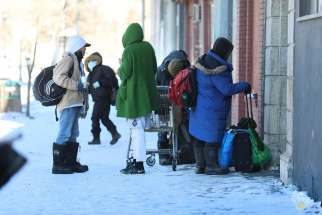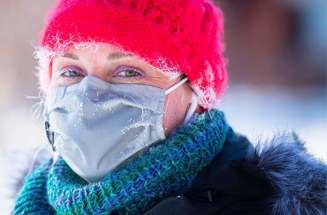Frozen face? Thank you! 'Normal' January misery delivers glorious and expected geographic brutality in our uncertain upside-down lives
Read this article for free:
or
Already have an account? Log in here »
To continue reading, please subscribe:
Monthly Digital Subscription
$0 for the first 4 weeks*
- Enjoy unlimited reading on winnipegfreepress.com
- Read the E-Edition, our digital replica newspaper
- Access News Break, our award-winning app
- Play interactive puzzles
*No charge for 4 weeks then price increases to the regular rate of $19.00 plus GST every four weeks. Offer available to new and qualified returning subscribers only. Cancel any time.
Monthly Digital Subscription
$4.75/week*
- Enjoy unlimited reading on winnipegfreepress.com
- Read the E-Edition, our digital replica newspaper
- Access News Break, our award-winning app
- Play interactive puzzles
*Billed as $19 plus GST every four weeks. Cancel any time.
To continue reading, please subscribe:
Add Free Press access to your Brandon Sun subscription for only an additional
$1 for the first 4 weeks*
*Your next subscription payment will increase by $1.00 and you will be charged $16.99 plus GST for four weeks. After four weeks, your payment will increase to $23.99 plus GST every four weeks.
Read unlimited articles for free today:
or
Already have an account? Log in here »
Hey there, time traveller!
This article was published 26/01/2021 (1787 days ago), so information in it may no longer be current.
At the time of this writing, the mercury is hovering at -30 C. There’s not a cloud in the sky, which is a crystalline, eye-watering blue. On social media, low-stakes debates about temperature vs. wind chill — and that meme asking, “Why am I living where the air hurts my face?” — have popped up like reliable old pals.
In other words, it’s a January day in Winnipeg. And it feels normal. Thrillingly, reassuringly normal.
The word “normal” has been used a lot over the course of the pandemic, in relation to both the before times and whatever is coming next. We are weeks away from a grim anniversary: one year since COVID-19 arrived in our province. One year since our lives changed completely, in big ways and small.

The concept of a “new normal” isn’t new. Humans have always been required to negotiate “new normals” after life-altering, irrevocable events — most strikingly, perhaps, when someone dies or when someone is born. Adjusting, adapting, reinventing, compromising, reimagining and, hopefully, growing: these are all things that are constantly demanded of us by virtue of being alive. Everything is temporary and nothing is certain.
What’s different about this past year, however, is the fact that we’re experiencing something life-altering and irrevocable on a global scale, together, at the same time. There are wide gulfs between our individual pandemic experiences — and suffering — but no one has been exempt from it. In times of uncertainty or grief, it makes sense to reach for the predictable rhythms of life, to find comfort in the familiar. But during a pandemic, many of those daily rhythms have been disrupted.

Recall that day last month when it was 6 C and raining? Recall how unsettling that felt? A -30 C day in January in Winnipeg gives the illusion that everything is in its place, that everything is how it should be. The glare of the sun still burns your eyes, the air still stings your lungs, and you are still alive.
There is symmetry between enduring a Winnipeg winter and enduring a pandemic. Both can seem like endless slogs that can often include physical discomfort, depression and cabin fever. Both require the ability to find small glimmers of light amid the darkness. The rhythm of lockdowns and the easing of restrictions is akin to a deep freeze followed by a thaw. The urge to hibernate is strong, but forced hibernation feels like punishment, which is why many Winnipeggers elected to stand in line at IKEA as soon as they were allowed to. Many of them were likely chasing that feeling: normal.
Writing about The Long Winter, the novel from Laura Ingalls Wilder’s Little House series that documents the blizzards that hammered the Dakotas in the winter of 1880–1881 when Laura was 14 years old, culture writer Anne Helen Peterson noted, “The book focuses on a spread of readily identifiable months with a specific and straightforward goal: endure. The chapters are, in truth, repetitive — but that’s the point. The long winter was long; it wasn’t experienced as a series of distractions and small delights, but as an extended nothingness, punctuated by work, dashed hopes, unplayable fiddles, too much sleep, and bread you weren’t even hungry for.”
Winter is a hard thing Winnipeggers endure — and survive — each and every year, a civic-pride badge won with hardiness and resilience. Sure, we fudge the numbers a bit; the wind chill value makes it sound worse than it is. If you’re among the lucky, then you have access to that series of distractions and small delights to break up the extended nothingness of winter, of a pandemic, of a pandemic in winter: Netflix, candles, the warm body of a dog curled up at your feet, a river to skate away on. And even if you cannot find joy in this season, you get through it, spurred on by the promise of spring.
But for those who are experiencing homelessness or insecure housing, weather like this can have devastating consequences — and some do not survive it. Like a pandemic, winter exacerbates problems that have always existed. Not everyone can hunker down and hold on. For those folks, a -30 C day in January is a terrible normalcy. Having one’s needs unmet and ignored is also a terrible normalcy.
“Normal” is often a thing to “get back to” or “return to,” even though “normal” is not that great for many people. But maybe “normal” is the wrong word. Maybe what we really mean is stable. The sensation of solid ground beneath your feet — and the reassuring idea that some things can be as sure as a cold day in January.
jen.zoratti@freepress.mb.ca
Twitter: @JenZoratti

Jen Zoratti is a Winnipeg Free Press columnist and author of the newsletter, NEXT, a weekly look towards a post-pandemic future.
Our newsroom depends on a growing audience of readers to power our journalism. If you are not a paid reader, please consider becoming a subscriber.
Our newsroom depends on its audience of readers to power our journalism. Thank you for your support.
History
Updated on Tuesday, January 26, 2021 9:31 PM CST: Removes word from last graph.






